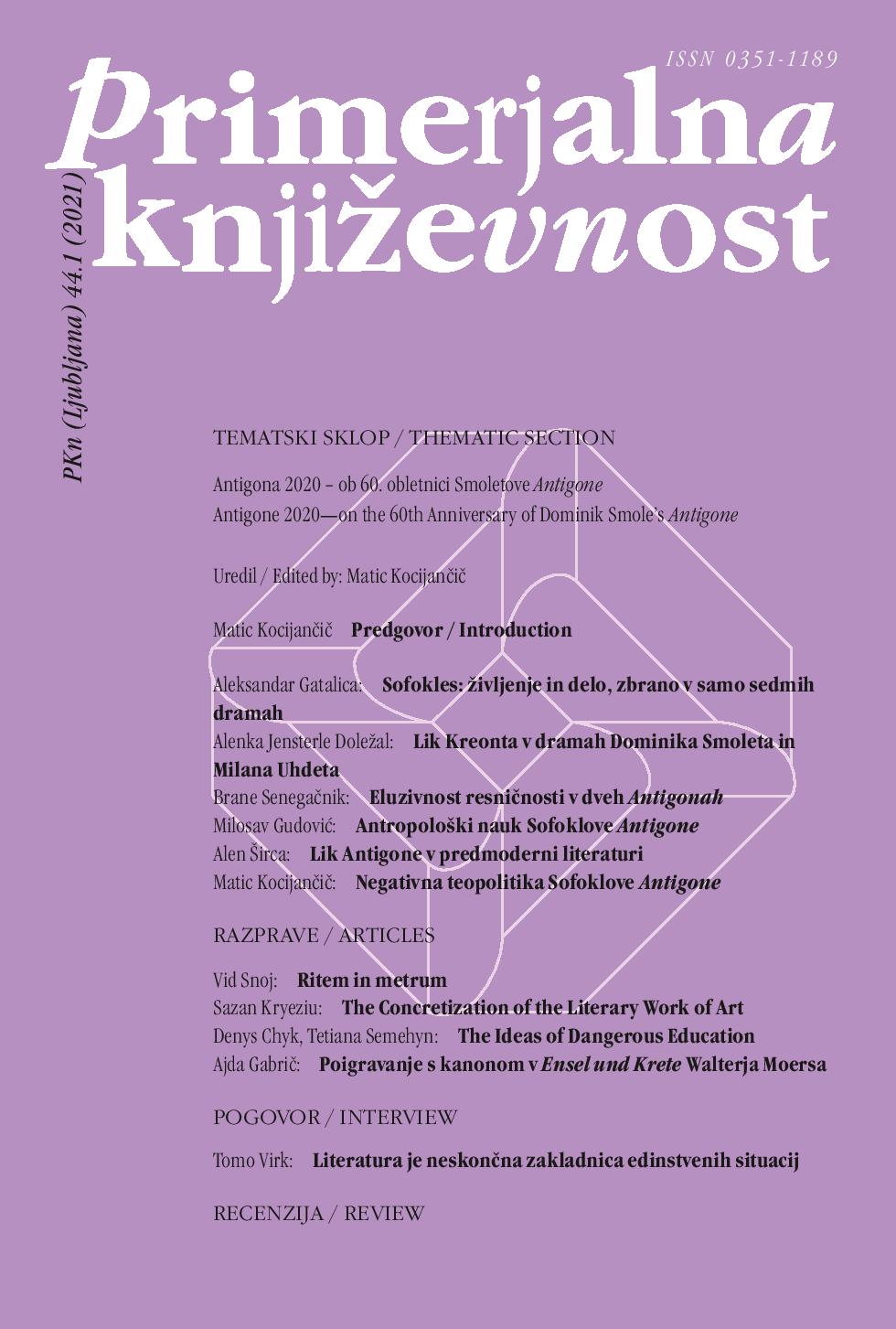The Figure of Antigone in Premodern Literature
DOI:
https://doi.org/10.3986/pkn.v44.i1.05Keywords:
ancient literature, medieval literature, tragedy, literary characters, Antigone, Sophocles, Euripides, Seneca, Statius, Dante, Chaucer, Gottfried, literary receptionAbstract
The article examines the figure of Antigone in European literature from antiquity to the end of the Middle Ages. After the period of classical Greek tragedy (Aeschylus, Sophocles, Euripides), Antigone as a literary figure undergoes the most significant adaptation in the Roman era, in Seneca’s tragedy The Phoenician Women and Statius’s epic Thebaid. In both works, Antigone is marked by Stoic determinism despite her rather active role. In the Middle Ages Antigone was a rather marginal literary figure. She is encountered mainly in the more or less free adaptations of Statius’s Thebaid, such as the medieval Irish prose work Togail na Tebe (The Destruction of Thebes) and the French epic Roman de Thèbes. Sporadic mentions of Antigone are also found in Dante, Boccaccio, and Christine de Pizan. The article notes that in medieval literature the thematization of Antigone is often characterized by an interweaving of two mythological figures (and traditions), the Theban and the (much less well-known) Trojan Antigone. Such literary contaminatio (contamination) of the two Antigones is most prominent in Chaucer’s epic Troilus and Criseyde. Finally, the discussion touches on the humanist reception of Antigone and draws attention to the hermeneutical problem of the literary reception of Antigone in general.
References
Ajshil. <em>Sedmerica proti Tebam</em>. Prev. Alojz Rebula. Maribor: Študentska založba Litera, 2010.
Dante Alighieri. <em>La Divina Commedia. Purgatorio</em>. Izd. Natalino Sapegno. Firenze: La Nuova Italia, 1990.
Dante Alighieri. <em>Božanska komedija. II. del, Vice</em>. Prev. Andrej Capuder. Maribor: Obzorja, 1972.
Chaucer, Geoffrey. <em>Troilus and Cryseide</em>. Prev. in op. Barry Windeatt. Oxford: Oxford University Press, 1998.
Euripides. <em>Bakhe, Alkestis, Feničanke</em>. Prev. Anton Sovrè. Ljubljana: Državna založba Slovenije, 1960.
<em>Le Roman de Thèbes</em>. 2. zv. Izd. Guy Raynaud de Lage. Pariz: Honoré Champion, 1969.
Ovid. <em>Metamorphoses</em>. Vol. 1. Izd. in prev. Frank Justus Miller. Cambridge, MA: Harvard University Press, 1971 (Loeb 42).
Propertius. <em>Elegies</em>. Izd. in prev. G. P. Goold. Cambridge, MA, London: Harvard University Press, 1990 (Loeb 18).
Propercij. Prev. Kajetan Gantar in Jože Mlinarič. Ljubljana: Mladinska knjiga, 1971 (Zbirka Lirika).
Seneca. <em>Tragedies II: Agamemnon, Thyestes, Hercules Oetaeus, Phoenissae, Octavia</em>. Izd. in prev. Frank Justus Miller. Cambridge, MA: Harvard University Press, 1968 (Loeb 78).
Statius. <em>Thebais</em>. 2 zv. Izd. in prev. J. H. Mozley. Cambridge, MA, London: Harvard University Press, 1928 (Loeb Classical Library).
Sophocles. <em>Antigone</em>. Izd. Mark Griffith. Cambridge: Cambridge University Press, 1999.
Sofokles. <em>Antigona</em>. Prev. Kajetan Gantar (pregl. in dop. prevod). Ljubljana: SNG Drama Ljubljana, 2017.
LITERATURA
Battles, Dominique. <em>The Medieval Tradition of Thebes: History and Narrative in the Roman de Thèbes, Boccacio, Chaucer, and Lydgate</em>. New York, NY: Routledge, 2004.
Behrman, Mary. »Heroic Criseyde«. <em>The Chaucer Review</em> 38.4 (2004): 314–336.
Brunhölzl, Franz. »Statius in MA«. <em>Lexikon des Mittelalters. VIII: Stadt (Byzantinisches Reich) bis Werl</em>. Stuttgart: Metzler, 1999. 67–68.
Donovan Ginsberg, Laura. »Don’t Stand So Close to Me: Antigone’s <em>Pietas</em> in Seneca’s <em>Phoenissae</em>«. <em>Transactions of the American Philological Association</em> 145.1 (2015): 199–230.
Edwards, Robert R. »Medieval Statius: Belatedness and Authority«. <em>Brill’s Companion to Statius</em>. Ur. W. J. Dominik, C. E. Newlands in K. Gervais. Leiden, Boston, MA: Brill, 2015. 497–511.
Fraisse, Simone. <em>Le mythe d’Antigone</em>. Pariz: Armand Colin, 1974.
Griffith, Mark. »Introduction«. <em>Antigone</em>. Sophocles. Izd. Mark Griffith. Cambridge: Cambridge University Press, 1999. 1–70.
Hard, Robin. <em>The Routledge Handbook of Greek Mythology. Based on H. J. Rose’s Handbook of Greek Mythology</em>. London: Routledge, 2004.
Heslin, Peter. »Statius in Dante’s Commedia«. <em>Brill’s Companion to Statius</em>. Ur. W. J. Dominik, C. E. Newlands in K. Gervais. Leiden, Boston, MA: Brill, 2015. 512–526.
Heslin, Peter. »Statius and the Greek Tragedians on Athens, Thebes and Rome«. <em>The Poetry of Statius</em>. Ur. R. R. Nauta, H.-J. van Dam in J. J. L. Smolenaars. Leiden: Brill, 2008. 111–128.
Hirschberg, Theo. <em>Senecas Phoenissen. Einleitung und Kommentar</em>. Berlin, New York, NY: Walter de Gruyter, 1989.
Kocijančič, Matic. »Kdo <em>ni</em> pokopal Polinejka? Skrivnost dvojnega pokopa v Sofoklovi <em>Antigoni</em>«. <em>Primerjalna književnost</em> 41.1 (2019): 9–27.
Kocijančič, Matic. <em>Mit o Antigoni v povojni slovenski književnosti, filozofiji in družbenopolitičnem diskurzu</em>. Doktorska disertacija. Ljubljana: Univerza v Ljubljani, Filozofska fakulteta, 2020.
Mastronarde, Donald J. <em>The Art of Euripides. Dramatic Technique and Social Context</em>. Cambridge: Cambridge University Press, 2010.
Miles, Brent. <em>Heroic Saga and Classical Epic in Medieval Ireland</em>. Cambridge: D. S. Brewer, 2011.
Miola, Robert S. »Early Modern Antigones: Receptions, Refractions«. <em>Classical Receptions Journal</em> 6.2 (2014): 221–244.
Mee, Erin B., in Helene P. Foley. »Mobilizing Antigone«. <em>Antigone on the Contemporary World Stage</em>. Ur. Erin B. Mee in Helene P. Foley. Oxford: Oxford University Press, 2011. 1–47.
O’Connor, Ralph. »Irish Narrative Literature and the Classical Tradition, 900–1300«. <em>Classical Literature and Learning in Medieval Irish Narrative</em>. Ur. Ralph O’Connor. Cambridge: D. S. Brewer, 2014. 1–24.
Senegačnik, Brane. »Humanistična branja Sofoklove <em>Antigone</em> in humanistično razumevanje humanega«. <em>Primerjalna književnost</em> 41.2 (2018): 169–189.
Steiner, George. <em>Antigones: The Antigone Myth in Western Literature, Art, and Thought</em>. Oxford: Oxford University Press, 1984.
Söffner, Jan. »Antigone«. <em>Mythenrezeption. Die antike Mythologie in Literatur, Musik und Kunst von den Anfängen bis zur Gegenwart</em>. Ur. Maria Moog-Grünewald. Stuttgart, Weimar: Metzler, 2008. 81–96.
Voigt, Astrid. »The Power of the Grieving Mind: Female Lament in Statius’s Thebaid«. <em>Illinois Classical Studies</em> 41.1 (2016): 59–84.
von Albrecht, Michael. <em>Geschichte der römischen Literatur. Von Andronicus bis Boethius und ihr Fortwirken</em>. 3. razšir. izd. Berlin: Walter de Gruyter, 2012.
Zimmermann, Christiane. <em>Der Antigone-Mythos in der antiken Literatur und Kunst</em>. Tübingen: Gunter Narr Verlag, 1993.


